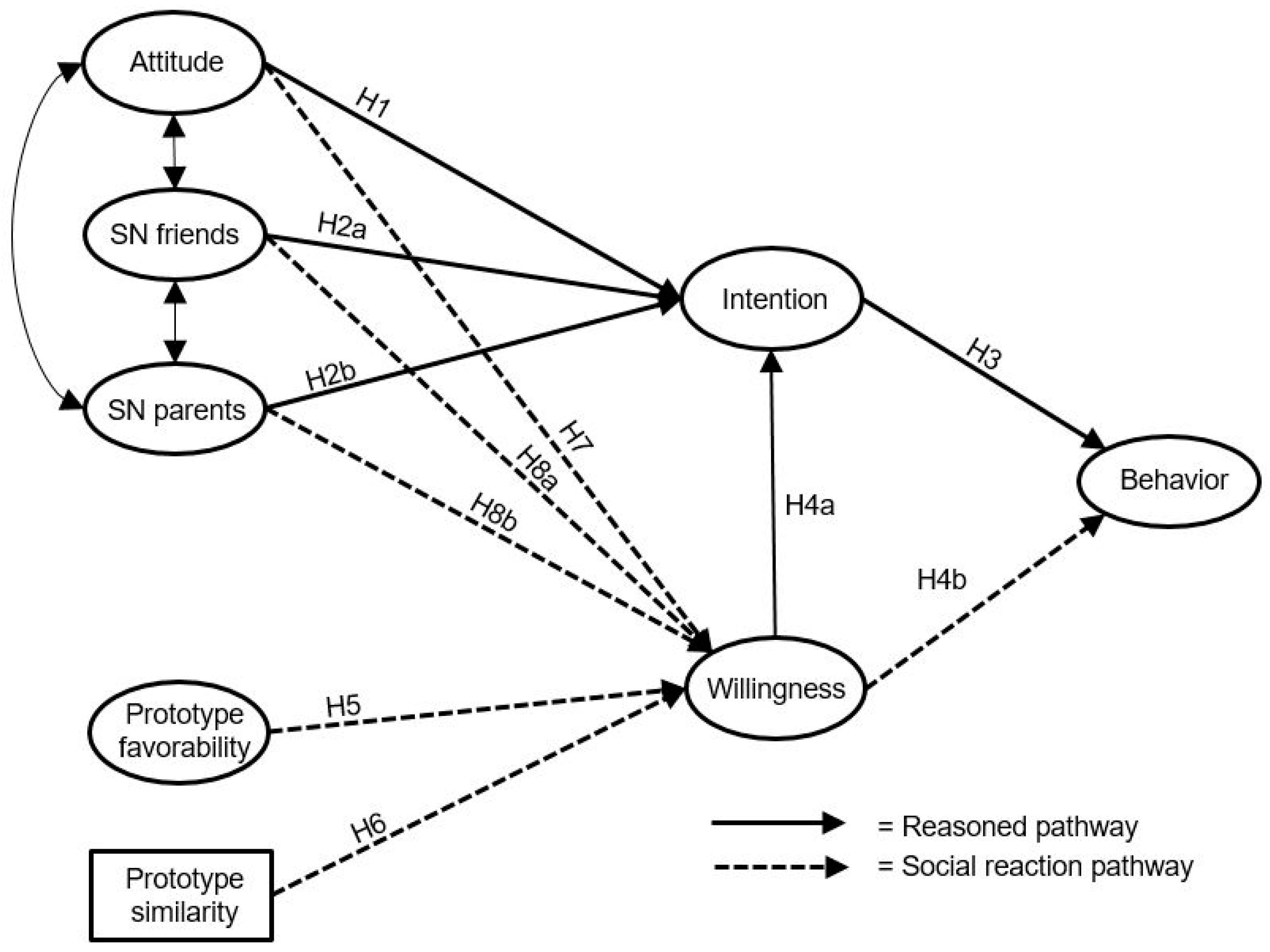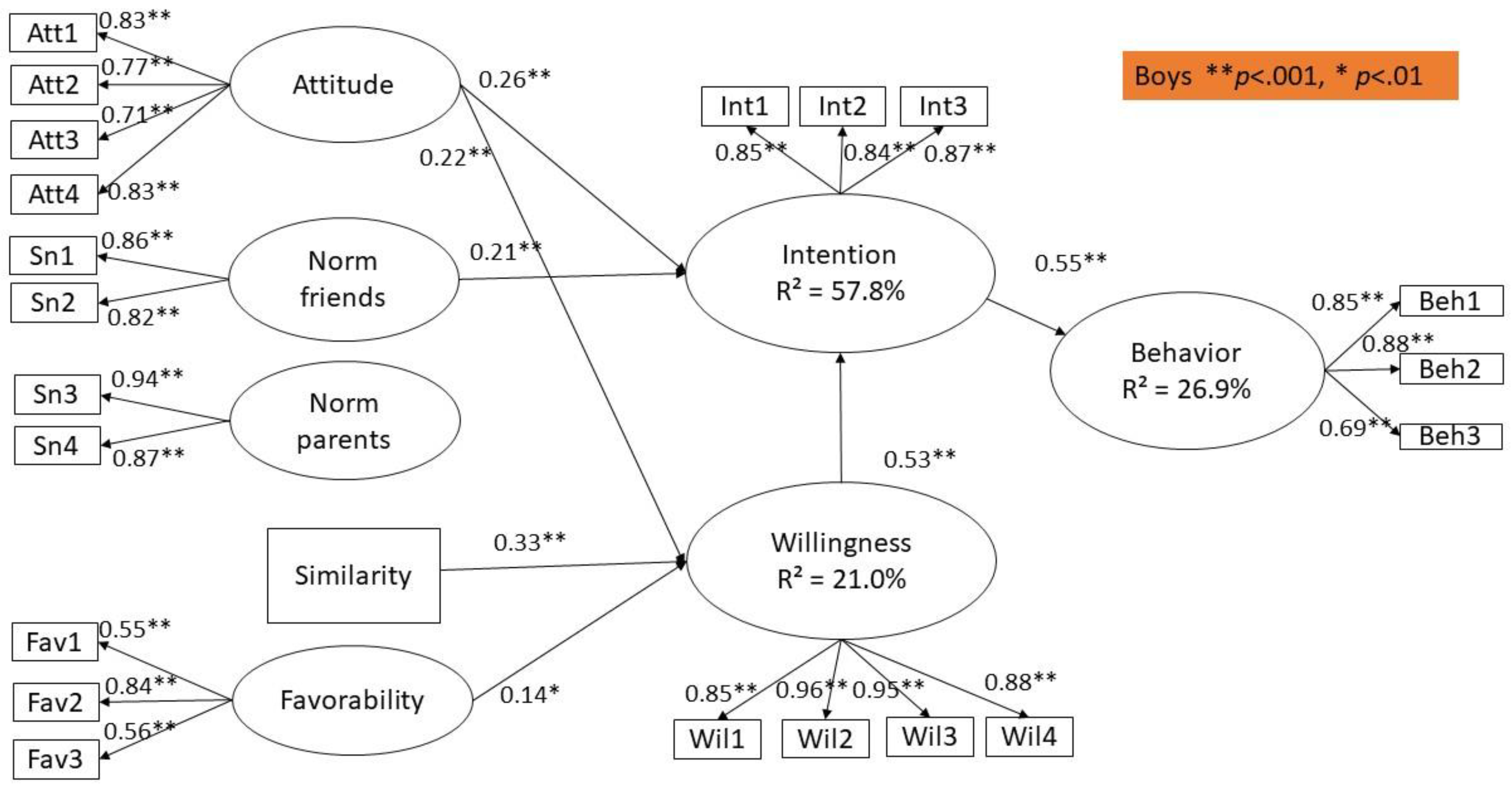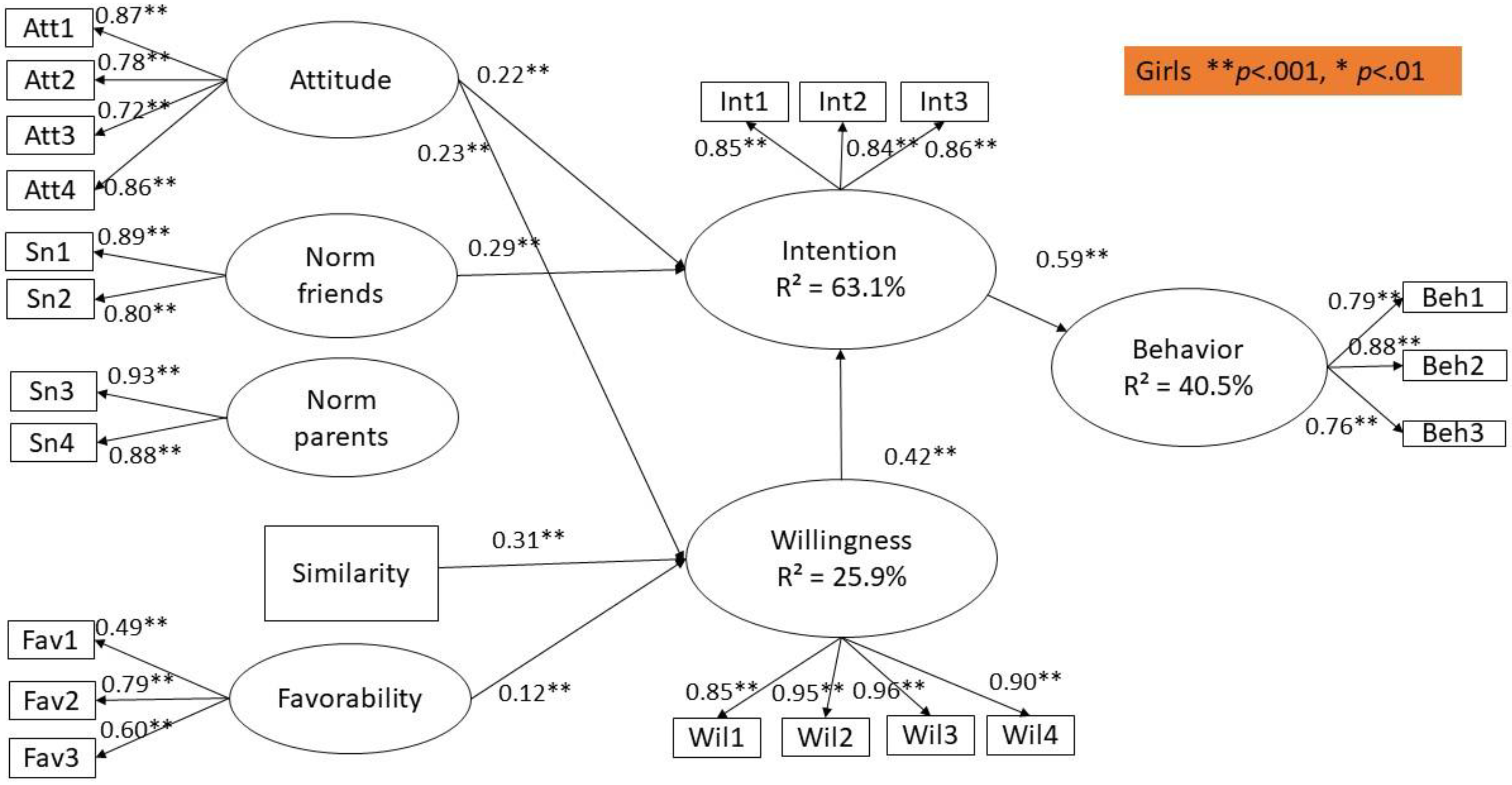Adolescents’ Sexy Self-Presentation on Instagram: An Investigation of Their Posting Behavior Using a Prototype Willingness Model Perspective
Abstract
1. Introduction
2. Literature Review
3. The Prototype Willingness Model
4. Methods
4.1. Sample and Procedures
4.2. Measures
4.2.1. Attitudes
4.2.2. Subjective Norm
4.2.3. Intention
4.2.4. Prototype Favorability
4.2.5. Prototype Similarity
4.2.6. Willingness
4.2.7. Behavior
4.3. Data Analytic Strategy
5. Results
5.1. Measurement Model
5.2. Structural Model
5.3. Sexualized Self-Presentation on Instagram for Boys
5.4. Sexualized Self-Presentation on Instagram for Girls
6. Discussion
7. Conclusions
Author Contributions
Funding
Conflicts of Interest
References
- Pew Research Center. Teens, Social Media & Technology 2018; Pew Research Center: Washington, DC, USA, 2018. [Google Scholar]
- EU Kids Online 2020: Survey Results from 19 Countries. Available online: https://www.eukidsonline.ch/files/Eu-kids-online-2020-international-report.pdf (accessed on 5 February 2020).
- Vandenbussche, E.; Callens, J.; Van Hecke, M.; Godfroid, N.; Vanhaelewyn, B.; Waeterloos, C.; Joris, G.; Ponnet, K.; Martens, M.; De Wolf, R.; et al. Onderzoeksrapport Apestaartjaren: De Digitale Leefwereld Van Jongeren; Research Report Apestaartjaren: The digital world of youth; Mediaraven: Ghent, Belgium, 2020; p. 46. [Google Scholar]
- Butkowski, C.P.; Dixon, T.L.; Weeks, K.R.; Smith, M.A. Quantifying the feminine self(ie): Gender display and social media feedback in young women’s Instagram selfies. New Media Soc. 2019, 22, 817–837. [Google Scholar] [CrossRef]
- Sheldon, P.; Newman, M. Instagram and American Teens: Understanding Motives for Its Use and Relationship to Excessive Reassurance-Seeking and Interpersonal Rejection. J. Soc. Media Soc. 2019, 8, 1–16. [Google Scholar]
- Van Gool, E.; Van Ouytsel, J.; Ponnet, K.; Walrave, M. To share or not to share? Adolescents’ self-disclosure about peer relationships on Facebook: An application of the Prototype Willingness Model. Comput. Hum. Behav. 2015, 44, 230–239. [Google Scholar] [CrossRef]
- Baker, S.A.; Walsh, M.J. ‘Good Morning Fitfam’: Top posts, hashtags and gender display on Instagram. New Media Soc. 2018, 20, 4553–4570. [Google Scholar] [CrossRef]
- Gibbons, F.X.; Gerrard, M.; Blanton, H.; Russell, D.W. Reasoned action and social reaction: Willingness and intention as independent predictors of health risk. J. Pers. Soc. Psychol. 1998, 74, 1164–1180. [Google Scholar] [CrossRef]
- Van Oosten, J.M. “Sexy Selfies”. The Role of Social Media in Adolescents’ (Self-) Sexualization. In Youth and Media; Kühne, R., Baumgartner, S.E., Koch, T., Hofer, M., Eds.; Nomos Verlagsgesellschaft mbH & Co. KG: Baden-Baden, Germany, 2018; pp. 187–202. [Google Scholar]
- Kapidzic, S.; Herring, S.C. Race, gender, and self-presentation in teen profile photographs. New Media Soc. 2014, 17, 958–976. [Google Scholar] [CrossRef]
- Vangeel, L.; Vandenbosch, L.; Eggermont, S. The multidimensional self-objectification process from adolescence to emerging adulthood. Body Image 2018, 26, 60–69. [Google Scholar] [CrossRef] [PubMed]
- Van Oosten, J.M.; Vandenbosch, L. Sexy online self-presentation on social network sites and the willingness to engage in sexting: A comparison of gender and age. J. Adolesc. 2017, 54, 42–50. [Google Scholar] [CrossRef] [PubMed]
- Lippman, J.R.; Campbell, S.W. Damned If You Do, Damned If You Don’t…If You’re a Girl: Relational and Normative Contexts of Adolescent Sexting in the United States. J. Child. Media 2014, 8, 371–386. [Google Scholar] [CrossRef]
- Van Royen, K.; Poels, K.; Vandebosch, H.; Walrave, M. Slut-Shaming 2.0. In Sexting: Motives and Risk in Online Sexual Self-Presentation; Walrave, M., Van Ouytsel, J., Ponnet, K., Temple, J.R., Eds.; Springer International Publishing: Cham, Switzerland, 2018; pp. 81–98. [Google Scholar]
- Van Ouytsel, J.; Lu, Y.; Ponnet, K.; Walrave, M.; Temple, J.R. Longitudinal associations between sexting, cyberbullying, and bullying among adolescents: Cross-lagged panel analysis. J. Adolesc. 2019, 73, 36–41. [Google Scholar] [CrossRef] [PubMed]
- Ojeda, M.; Del-Rey, R.; Hunter, S.C. Longitudinal relationships between sexting and involvement in both bullying and cyberbullying. J. Adolesc. 2019, 77, 81–89. [Google Scholar] [CrossRef]
- Ajzen, I. The theory of planned behavior. Organ. Behav. Hum. Decis. Process. 1991, 50, 179–211. [Google Scholar] [CrossRef]
- Steinberg, L. Adolescence, 9th ed.; McGraw-Hill Humanities: New York, NY, USA, 2011. [Google Scholar]
- Baumgartner, S.E.; Valkenburg, P.M.; Peter, J. The Influence of Descriptive and Injunctive Peer Norms on Adolescents’ Risky Sexual Online Behavior. Cyberpsychol. Behav. Soc. Netw. 2011, 14, 753–758. [Google Scholar] [CrossRef]
- Walrave, M.; Ponnet, K.; Van Ouytsel, J.; Van Gool, E.; Heirman, W.; Verbeek, A. Whether or not to engage in sexting: Explaining adolescent sexting behaviour by applying the prototype willingness model. Telemat. Inform. 2015, 32, 796–808. [Google Scholar] [CrossRef]
- Van Ouytsel, J.; Ponnet, K.; Walrave, M.; D’Haenens, L. Adolescent sexting from a social learning perspective. Telemat. Inform. 2017, 34, 287–298. [Google Scholar] [CrossRef]
- Ringrose, J.; Gill, R.; Livingstone, S.; Harvey, L. A Qualitative Study of Children, Young People and ‘sexting’: A Report Prepared for the NSPCC; National Society for the Prevention of Cruelty to Children: London, UK, 2012. [Google Scholar]
- Vanwesenbeeck, I.; Ponnet, K.; Walrave, M.; Van Ouytsel, J. Parents’ Role in Adolescents’ Sexting Behaviour. In Sexting: Motives and Risk in Online Sexual Self-Presentation; Walrave, M., Van Ouytsel, J., Ponnet, K., Temple, J.R., Eds.; Springer International Publishing: Cham, Switzerland, 2018; pp. 63–80. [Google Scholar]
- Gibbons, F.X.; Gerrard, M.; Lune, L.S.V.; Wills, T.A.; Brody, G.; Conger, R.D. Context and Cognitions: Environmental Risk, Social Influence, and Adolescent Substance Use. Pers. Soc. Psychol. Bull. 2004, 30, 1048–1061. [Google Scholar] [CrossRef]
- Muthén, L.; Muthén, B. Mplus Users’ Guide 7th Edition, 6th ed.; Muthén & Muthén: Los Angeles, CA, USA, 2012. [Google Scholar]
- Kline, R.B. Principles and Practice of Structural Equation Modeling; Guilford Press: New York, NY, USA, 2011. [Google Scholar]
- Bentler, P.M. Comparative fit indexes in structural models. Psychol. Bull. 1990, 107, 238–246. [Google Scholar] [CrossRef]
- Tucker, L.R.; Lewis, C. A reliability coefficient for maximum likelihood factor analysis. Psychometrika 1973, 38, 1–10. [Google Scholar] [CrossRef]
- Steiger, J.H. Structural Model Evaluation and Modification: An Interval Estimation Approach. Multivar. Behav. Res. 1990, 25, 173–180. [Google Scholar] [CrossRef]
- Byrne, B.M. Structural Equation Modeling With AMOS, EQS, and LISREL: Comparative Approaches to Testing for the Factorial Validity of a Measuring Instrument. Int. J. Test. 2001, 1, 55–86. [Google Scholar] [CrossRef]
- Hu, L.T.; Bentler, P.M. Cutoff criteria for fit indexes in covariance structure analysis: Conventional criteria versus new alternatives. Struct. Equ. Modeling 1999, 6, 1–55. [Google Scholar] [CrossRef]
- Ponnet, K. Financial Stress, Parent Functioning and Adolescent Problem Behavior: An Actor–Partner Interdependence Approach to Family Stress Processes in Low-, Middle-, and High-Income Families. J. Youth Adolesc. 2014, 43, 1752–1769. [Google Scholar] [CrossRef] [PubMed]
- Ringrose, J.; Harvey, L. Boobs, back-off, six packs and bits: Mediated body parts, gendered reward, and sexual shame in teens’ sexting images. Continuum 2015, 29, 205–217. [Google Scholar] [CrossRef]
- Ringrose, J.; Harvey, L.; Gill, R.; Livingstone, S. Teen girls, sexual double standards and ‘sexting’: Gendered value in digital image exchange. Fem. Theory 2013, 14, 305–323. [Google Scholar] [CrossRef]
- Daniels, E.A.; Zurbriggen, E.L. “It’s Not the Right Way to Do Stuff on Facebook:” An Investigation of Adolescent Girls’ and Young Women’s attitudes Toward Sexualized Photos on Social Media. Sex. Cult. 2016, 20, 936–964. [Google Scholar] [CrossRef]
- Armstrong, E.A.; Hamilton, L.T.; Armstrong, E.M.; Seeley, J.L. “Good Girls”: Gender, Social Class, and Slut Discourse on Campus. Soc. Psychol. Q. 2014, 77, 100–122. [Google Scholar] [CrossRef]
- Van Ouytsel, J.; Van Gool, E.; Walrave, M.; Ponnet, K.; Peeters, E. Sexting: Adolescents’ perceptions of the applications used for, motives for, and consequences of sexting. J. Youth Stud. 2016, 20, 1–25. [Google Scholar] [CrossRef]
- Walrave, M.; Heirman, W.; Hallam, L. Under pressure to sext? Applying the theory of planned behaviour to adolescent sexting. Behav. Inf. Technol. 2013, 33, 86–98. [Google Scholar] [CrossRef]
- Stanley, N.; Barter, C.; Wood, M.; Aghtaie, N.; Larkins, C.; Lanau, A.; Överlien, C. Pornography, Sexual Coercion and Abuse and Sexting in Young People’s Intimate Relationships: A European Study. J. Interpers. Violence 2016, 33, 2919–2944. [Google Scholar] [CrossRef]
- Van Ouytsel, J.; Ponnet, K.; Walrave, M. The Associations between Adolescents’ Consumption of Pornography and Music Videos and Their Sexting Behavior. Cyberpsychol. Behav. Soc. Netw. 2014, 17, 772–778. [Google Scholar] [CrossRef]
- Trekels, J.; Karsay, K.; Eggermont, S.; VandenBosch, L. How Social and Mass Media Relate to Youth’s Self-Sexualization: Taking a Cross-National Perspective on Rewarded Appearance Ideals. J. Youth Adolesc. 2018, 47, 1440–1455. [Google Scholar] [CrossRef]
- Akers, R.L.; Jennings, W. Social Learning Theory. In 21st Century Criminology: A Reference Handbook; Miller, J., Ed.; Sage Publications, Inc.: Thousand Oaks, CA, USA, 2009; pp. 323–332. [Google Scholar]
- Steele, J.R.; Brown, J.D. Adolescent room culture: Studying media in the context of everyday life. J. Youth Adolesc. 1995, 24, 551–576. [Google Scholar] [CrossRef]
- Wood, M.; Barter, C.; Stanley, N.; Aghtaie, N.; Larkins, C. Images across Europe: The sending and receiving of sexual images and associations with interpersonal violence in young people’s relationships. Child. Youth Serv. Rev. 2015, 59, 149–160. [Google Scholar] [CrossRef]
- Van Ouytsel, J.; Walrave, M.; De Marez, L.; Van Damme, K.; De Wolf, R.; Baccarne, B.; Vanhaelewyn, B.; Ponnet, K. Concise report: Teenage sexting on the rise? Results of a cohort study using a weighted sample of adolescents. Sex. Health 2020, 17, 178–181. [Google Scholar] [CrossRef]
- Lee, C.-H.; Moak, S.; Walker, J.T. Effects of Self-Control, Social Control, and Social Learning on Sexting Behavior among South Korean Youths. Youth Soc. 2013, 48, 242–264. [Google Scholar] [CrossRef]
- Symons, K.; Ponnet, K.; Walrave, M.; Heirman, W. Sexting scripts in adolescent relationships: Is sexting becoming the norm? New Media Soc. 2018, 20, 3836–3857. [Google Scholar] [CrossRef]
- Baumgartner, S.E.; Sumter, S.R.; Peter, J.; Valkenburg, P.M. Sexual self-presentation on social network sites: Who does it and how is it perceived? Comput. Hum. Behav. 2015, 50, 91–100. [Google Scholar] [CrossRef]
- Del Rey, R.; Ortega-Ruiz, R.; Casas, J.A. Asegúrate: An Intervention Program against Cyberbullying Based on Teachers’ Commitment and on Design of Its Instructional Materials. Int. J. Environ. Res. Public Health 2019, 16, 434. [Google Scholar] [CrossRef]
- Ahern, N.R.; Mechling, B. Sexting: Serious Problems for Youth. J. Psychosoc. Nurs. Ment. Health Serv. 2013, 51, 22–30. [Google Scholar] [CrossRef] [PubMed]
- Livingstone, S.; Görzig, A. When adolescents receive sexual messages on the internet: Explaining experiences of risk and harm. Comput. Hum. Behav. 2014, 33, 8–15. [Google Scholar] [CrossRef]
- Davis, N.; Schmidt, C. Cyberbullying and Cyber Abuse Intervention: The Three-Tiered Model for Schools. J. Creat. Ment. Health 2016, 11, 366–377. [Google Scholar] [CrossRef]
- Van Ouytsel, J.; Walrave, M.; Ponnet, K. How Schools Can Help Their Students to Strengthen Their Online Reputations. Clear. House J. Educ. Strateg. Issues Ideas 2014, 87, 180–185. [Google Scholar] [CrossRef]
- Livingstone, S.; Helsper, E.J. Parental Mediation of Children’s Internet Use. J. Broadcast. Electron. Media 2008, 52, 581–599. [Google Scholar] [CrossRef]
- Armitage, C.J.; Conner, M. Efficacy of the theory of planned behaviour: A meta-analytic review. Br. J. Soc. Psychol. 2001, 40, 471. [Google Scholar] [CrossRef]
- Pomery, E.A.; Gibbons, F.X.; Reis-Bergan, M.; Gerrard, M. From Willingness to Intention: Experience Moderates the Shift From Reactive to Reasoned Behavior. Pers. Soc. Psychol. Bull. 2009, 35, 894–908. [Google Scholar] [CrossRef]
- Rivis, A.; Sheeran, P. Social Influences and the Theory of Planned Behaviour: Evidence for a Direct Relationship Between Prototypes and Young People’s Exercise Behaviour. Psychol. Health 2003, 18, 567–583. [Google Scholar] [CrossRef]
- Spijkerman, R.; Eijnden, R.J.V.D.; Vitale, S.; Engels, R.C. Explaining adolescents’ smoking and drinking behavior: The concept of smoker and drinker prototypes in relation to variables of the theory of planned behavior. Addict. Behav. 2004, 29, 1615–1622. [Google Scholar] [CrossRef] [PubMed]
- Bandura, A. Social Foundations of Thought and Action. In The Health Psychology Reader; SAGE Publications: Thousand Oaks, CA, USA, 1986; pp. 23–28. [Google Scholar]
- Bandura, A. Social Cognitive Theory of Mass Communication. Media Psychol. 2001, 3, 265–299. [Google Scholar] [CrossRef]
- Simpson, C.C.; Mazzeo, S.E. Skinny Is Not Enough: A Content Analysis of Fitspiration on Pinterest. Health Commun. 2016, 32, 560–567. [Google Scholar] [CrossRef] [PubMed]
- Casas, J.A.; Ojeda, M.; Eelipe, P.; Del Rey, R. Exploring which factors contribute to teens’ participation in sexting. Comput. Hum. Behav. 2019, 100, 60–69. [Google Scholar] [CrossRef]
- Gültzow, T.; Guidry, J.P.; Schneider, F.; Hoving, C. Male Body Image Portrayals on Instagram. Cyberpsychology Behav. Soc. Netw. 2020, 23, 281–289. [Google Scholar] [CrossRef]
- Jacobson, J.; Gruzd, A. Cybervetting job applicants on social media: The new normal? Ethic Inf. Technol. 2020, 22, 175–195. [Google Scholar] [CrossRef]
- Berkelaar, B.L.; Harrison, M.A. Cybervetting. In The International Encyclopedia of Organizational Communication; Wiley: Hoboken, NJ, USA, 2016; pp. 1–7. [Google Scholar]
- Kalina, C.; Powell, K. Cognitive and social costructivism: Developing tools for an effective classroom. Education 2009, 130, 241–250. [Google Scholar]
- Davidson, J. Teen Boys and the Phenomenon of Sexting. In Sexting; Brill | Sense: Leiden, The Netherlands, 2014; pp. 41–59. [Google Scholar]
- Meeus, W.; Van Ouytsel, J.; Driesen, A.; T’Sas, J. Media didactica: A media literacy reference framework for learners, teachers and teacher educators. MerzWissenschaft 2014, 58, 41–49. [Google Scholar]



| M | SD | |
|---|---|---|
| Attitudes | ||
| Att1. Bad-good | 2.13 | 0.94 |
| Att2. Disadvantageous-advantageous | 2.15 | 0.94 |
| Att3. Harmful-harmless | 2.32 | 1.07 |
| Att4. A bad idea-a good idea | 2.00 | 0.94 |
| Subjective norm-Friends | ||
| Sn1. I think my friends would approve if posted sexy images of myself on Instagram | 2.89 | 1.38 |
| Sn2. I think that generally speaking my friends would not mind if I posted sexy images of myself on Instagram | 3.32 | 1.39 |
| Subjective norm-Parents | ||
| Sn3. I think my parents would approve if posted sexy images of myself on Instagram | 2.01 | 1.19 |
| Sn4. I think that generally speaking my parents would not mind if I posted sexy images of myself on Instagram | 2.08 | 1.26 |
| Prototype favorability | ||
| Fav1. Popular | 4.44 | 1.55 |
| Fav2. Sexy | 4.08 | 1.56 |
| Fav3. Adventurous | 3.34 | 1.56 |
| Prototype similarity | ||
| How similar do you think you are to somebody who posts sexy images of themselves on Instagram “not at all-totally” | 1.93 | 1.04 |
| Willingness | ||
| Wil1. After some hesitation, I would also post sexy images of myself on Instagram | 1.79 | 1.00 |
| Wil2. I would do the same and post sexy images of myself on Instagram | 1.64 | 0.91 |
| Wil3. I would also post sexy images of myself on Instagram | 1.65 | 0.94 |
| Wil4. I would react and also post sexy images of myself on Instagram | 1.65 | 0.95 |
| Intention | ||
| Int1. I am inclined to post sexy images of myself on Instagram | 1.72 | 0.97 |
| Int2. There is a chance that I would post sexy images of myself on Instagram | 2.17 | 1.23 |
| Int3. I want to share sexy images of myself on Instagram | 1.72 | 0.99 |
| Behavior How often in the past 6 months have you posted images of yourself in which you were depicted with… | ||
| Beh1. With a sexy gaze | 1.52 | 1.01 |
| Beh2. With a sexy appearance | 1.60 | 1.11 |
| Beh3. In a sexy posture | 1.30 | 0.83 |
| 1 | 2 | 3 | 4 | 5 | 6 | 7 | 8 | |
|---|---|---|---|---|---|---|---|---|
| Attitude | / | |||||||
| Social norm friends | 0.67 ** | / | ||||||
| Social norm parents | 0.61 ** | 0.73 ** | / | |||||
| Intention | 0.61 ** | 0.60 ** | 0.50 ** | / | ||||
| Willingness | 0.42 ** | 0.36 ** | 0.32 ** | 0.67 ** | / | |||
| Prototype favorability | 0.37 ** | 0.36 ** | 0.29 ** | 0.36 ** | 0.31 ** | / | ||
| Behavior | 0.46 ** | 0.36 ** | 0.33 ** | 0.56 ** | 0.38 ** | 0.18 ** | / | |
| Prototype similarity | 0.39 ** | 0.36 ** | 0.33 ** | 0.53 ** | 0.44 ** | 0.34 * | 0.39 ** | / |
Publisher’s Note: MDPI stays neutral with regard to jurisdictional claims in published maps and institutional affiliations. |
© 2020 by the authors. Licensee MDPI, Basel, Switzerland. This article is an open access article distributed under the terms and conditions of the Creative Commons Attribution (CC BY) license (http://creativecommons.org/licenses/by/4.0/).
Share and Cite
Van Ouytsel, J.; Walrave, M.; Ojeda, M.; Del Rey, R.; Ponnet, K. Adolescents’ Sexy Self-Presentation on Instagram: An Investigation of Their Posting Behavior Using a Prototype Willingness Model Perspective. Int. J. Environ. Res. Public Health 2020, 17, 8106. https://doi.org/10.3390/ijerph17218106
Van Ouytsel J, Walrave M, Ojeda M, Del Rey R, Ponnet K. Adolescents’ Sexy Self-Presentation on Instagram: An Investigation of Their Posting Behavior Using a Prototype Willingness Model Perspective. International Journal of Environmental Research and Public Health. 2020; 17(21):8106. https://doi.org/10.3390/ijerph17218106
Chicago/Turabian StyleVan Ouytsel, Joris, Michel Walrave, Mónica Ojeda, Rosario Del Rey, and Koen Ponnet. 2020. "Adolescents’ Sexy Self-Presentation on Instagram: An Investigation of Their Posting Behavior Using a Prototype Willingness Model Perspective" International Journal of Environmental Research and Public Health 17, no. 21: 8106. https://doi.org/10.3390/ijerph17218106
APA StyleVan Ouytsel, J., Walrave, M., Ojeda, M., Del Rey, R., & Ponnet, K. (2020). Adolescents’ Sexy Self-Presentation on Instagram: An Investigation of Their Posting Behavior Using a Prototype Willingness Model Perspective. International Journal of Environmental Research and Public Health, 17(21), 8106. https://doi.org/10.3390/ijerph17218106








